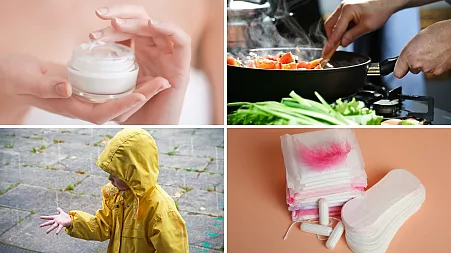Tampons have come a long way since their earliest uses. In the 5th century B.C., Greeks made them from lint wrapped around small pieces of wood, as noted by Hippocrates, "the father of medicine". The ancient Romans preferred wool, while other cultures have used materials including paper in Japan, vegetable fibers in Indonesia, sponges, and grass in equatorial Africa.
Fast forward to 1929 in America, and tampons became a modern convenience, though not without evolving challenges.
For decades, tampons have been a staple in menstrual care in America. Despite their popularity, a recent study has raised significant health concerns due to the presence of toxic metals like lead, arsenic, and cadmium in various tampon brands.
The study, led by a University of California, Berkeley, has revealed that women are at risk of significant implications due to the high absorption potential of the vaginal skin, which can lead to various health issues, including cancer and infertility. These findings have led Newsweek to seek safer alternatives.
In 2020, 34.1 million women in the U.S. used tampons, according to data from Statista, based on United Nations and Simmons National Consumer Survey (NHCS) data. Today, women are urged to re-consider their options and Newsweek spoke to experts who could explain the choices.
"It is becoming inherently clear that intimate health and well-being were an afterthought for manufacturers of women's health products for decades," said Anna Butterworth, founder of Ultra Violet Agency, which is globally dedicated to trend forecasting in women's health and FemTech.
Although tampons remain available, women are likely to shift toward alternative sanitary products recommended by both Butterworth and Dr. Anna Targonskaya, a gynecologist.
"Tampons themselves are not the problem, but the choice of ingredients and the manufacturing process is putting women at risk," said Butterworth. "It's important that all people with periods have a wide range of choices available to them to manage their flow as it changes throughout the month and throughout their lives."
Functional Menstrual Products
Butterworth, who is also known as a women's health forecaster, predicts a major trend emerging that involves functional menstrual products designed to have more than one purpose.
She explained, "What we will see emerge in this space is functional menstrual products. Products will detect the onset of certain bacterial infections or major health conditions like Diabetes, HPV, Thyroid or Fertility function."
Today, women can already purchase FDA-approved menstrual blood testing products from Qvin. The Q-Pad A1c Test uses menstrual blood to measure your average blood sugar through your A1c biomarker.
Reusable Cloth Pads and Period Pants
Butterworth identified another emerging trend in menstrual care, that consumers are likely to diversify their product range to include more reusable and natural options.
"That means broader use of menstrual cups and discs, period pants and reusable pads and these products will all be made with body safe materials with a strong focus on ingredients that support both the vaginal flora and the planet. Some great examples available now are Aisle (though they still have some Virgin Polyester) and Nixit," she suggested.
Targonskaya added: "If you'd like to avoid tampons, then I'd suggest looking into the world of reusable cloth pads or period pants. These are underwear you can bleed straight into, without having to worry about leaking. Different brands use different materials, with bamboo, cotton and merino wool being the most popular. You can keep them on all day and then just put them in the wash afterward, making them a safe, simple, and sustainable menstrual product option."
Menstrual Cups
Targonskaya, who works at the hormone tracking app Hormona, highlights menstrual cups as a leading alternative.
She told Newsweek: "When it comes to choosing a product that's best for your health, and better for the planet, the menstrual cup is a great option that is dominating the period market.
"They are made of silicone or latex plastic, should be BPA and chemical-free, and they can last you up to ten years. Although they can take a while to get used to using, once you've got the process mastered they can be safely left in for up to 12 hours, depending on your flow. It's really important that users give it a thorough clean with boiling water at the end of each cycle, to make sure they're safe and sterile to use again."
4 Tips for Using Menstrual Cups and Discs
Kim Rosas, a reusable period products educator and founder of Period Nirvana, a detailed resource for menstrual cup and disc users, has provided the following tips for consumers who want to look at tampon alternatives in light of the study.
Rosas, based in Charlotte, North Carolina, acknowledges that trying these products for the first time can be "overwhelming," but she hopes these tips will simplify the process.
- Find the Right Fit: Menstrual discs are typically "one size fits most," but those with a low cervix may need a size Small disc. Generally, those under 30 with no full-term pregnancy suggests a Small, while over 30 and/or having had a full-term pregnancy suggests a Large.
- Be Prepared for the Learning Curve: During your first period with a new cup or disc, use a backup liner or period underwear to catch any leaks. It usually takes two or three cycles to get accustomed to using the cup or disc without leaks.
- Stay Calm and Use Lubrication if Needed: Inserting a menstrual cup can be intimidating at first. Relax and consider using a water-based lubricant to make the process smoother. It's normal to feel nervous initially, but it becomes easier with practice.
- Manage Public Use Confidently: Menstrual cups and discs can be worn for up to 12 hours, so you often won't need to empty them in public. If you do, simply empty and reinsert the cup or disc while staying in the stall. You can use menstrual cup cleaning wipes if desired, and wash it thoroughly once you're home. Sleeping with a cup or disc in is also safe and comfortable.
In conclusion, the revelation of toxic metals in tampons has spurred a movement toward safer and more sustainable menstrual care products. Whether opting for menstrual cups, reusable pads, or innovative health-monitoring tampons, it's essential to choose products that support both health and the environment.
Is there a health issue that's worrying you? Let us know via health@newsweek.com. We can ask experts for advice, and your story could be featured on Newsweek.
Disclaimer: The copyright of this article belongs to the original author. Reposting this article is solely for the purpose of information dissemination and does not constitute any investment advice. If there is any infringement, please contact us immediately. We will make corrections or deletions as necessary. Thank you.




